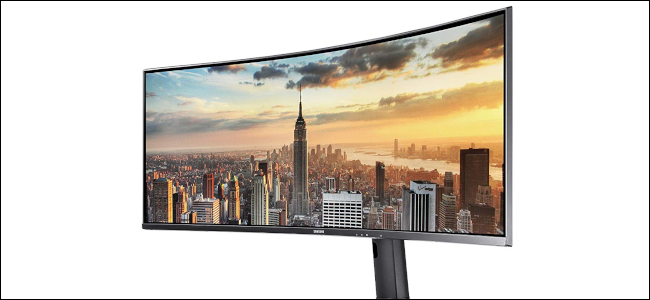Quick Links
There's only one thing the PC gaming world loves more than games, and that's inscrutable terminology. "Yeah, my display's got G-Sync, 1ms GTG, a 16:9 aspect ratio, plus it's HDR, of course. Man, you won't see any ghosting on this baby."
If those few sentences were a jumble of meaningless words to you, this article intends to decrypt all those specialized terms and help you figure out what's most important for your gaming experience. There are all kinds of unique terminology for PC parts, including processors, graphics cards, and motherboards. Many of those terms you can safely ignore and get whatever's considered the best part for your price range.
Monitors are a little different. They're visual, and everyone's got their own opinion about what looks good---which monitor's colors are too washed out or which one doesn't have enough visual "pop." Even the type of graphics card you have can influence your choice of monitor.
With that in mind, let's dive into the wild world of monitor technology.
Refresh Rate
A refresh rate is how fast your monitor can change its image---yes, even in our technological age, video is still just a set of still images changing superfast. The speed at which a display image changes is measured in hertz (Hz). If you have a 120 Hz display, for example, it can refresh 120 times per second. A 60 Hz monitor does half of that, at 60 times per second, and a 144 Hz refresh rate means it can change 144 times every second.
Most of the monitors in the world today are rocking a standard 60 Hz refresh rate. The more prized gaming monitors, however, have refresh rates of 120 and 144 Hz. The higher the refresh rate, the smoother a game is rendered on-screen, assuming your graphics card is up to the task.
G-Sync and FreeSync
Going hand in hand with the refresh rate is Nvidia G-Sync and AMD's FreeSync. Each graphics card company supports its own version of variable refresh rate technology (also referred to as adaptive sync). This is when your graphics card and monitor sync their refresh rates to deliver a more consistent, smoother image.
When a graphics card is pushing more frames than the monitor can display, you end up with screen tearing. This is when portions of the current image and the next are displayed on your screen at the same time.
Not only does this lead to an ugly gaming experience, but it can also give you a headache or even nausea if you're sensitive to it.
So, adaptive sync is great, but you have to have a graphics card that supports the technology before it'll work. Generally, that means anyone with an Nvidia GeForce card gets a G-Sync monitor, and anyone with an AMD Radeon graphics card uses FreeSync.
There is one wrinkle to this, however, as some FreeSync monitors also support G-Sync. This is great news, as FreeSync monitors tend to be cheaper than their G-Sync counterparts. There are only a handful of FreeSync monitors that are "G-Sync Compatible," however, so don't forget to check out reviews to see how well "G-Sync on FreeSync" works before purchasing.
Input Lag
The refresh rate is only part of a very large equation. Another issue to consider is input lag, which has two definitions to make things even more confusing. The good news is both meanings are simple ideas.
When most people talk about input lag, they're talking about the moment between when you strike a key on your keyboard, click a mouse, or move a controller, and when that action is reflected on-screen. If there's no perceptible lag, then your keystrokes, mouse clicks, and other inputs appear to be immediate. If there's lag, you might fire your gun, and then it takes half a second or longer before that action happens on-screen. This is bad when playing---especially if you're trying to get the jump on another human player in a game like Fortnite.
The second definition has to do with the image. There's always a small delay between when a video signal hits the monitor and when it appears on-screen. These few milliseconds are sometimes referred to as input lag but is more correctly referred to as display lag.
Whatever you call it, the result is, when playing a fast-moving game, the bad guys can attack before you even know they're there, or your character moves to a place he shouldn't before you realize it and ends up dead.
Controller input lag or display lag makes a monitor look bad, so you won't find these numbers advertised on an Amazon product page. Plus, input lag isn't just a question of your monitor's capabilities. It can be affected by your system or in-game graphics settings, such as V-Sync.
To find out if your prospective monitor has a serious input or display lag issue look at reviews via a simple web search, such as "input lag [Monitor X]." Most monitors should be fine for most uses, but if you're playing a competitive game, like CS:GO, then reducing any input lag matters.
Response Time
We've got a nice, long explanation about response time for those who want to read about its finer points. Briefly, though, response time is how long it takes for pixels on a monitor to change from one color to another, and it's measured in milliseconds. It's often measured by timing how long it takes to go from black to white, and back again. Sometimes, however, you'll see a response time that says something like 4 ms (GTG). That means gray-to-gray; the monitor starts with gray and then shifts through a whole bunch of other shades of gray.
Generally, the lower the response time, the better, because it means the pixels on your screen can transition quickly enough to get to the next frame. That sounds a lot like the refresh rate, and that's because the two concepts are related. The refresh rate is the high-level concept indicating how many image frames can be displayed on your monitor within one second. Response time is the lower level work the individual pixels do moving from one frame to the next.
If the pixels aren't moving to the next image fast enough, you can end up with visual artifacts on the screen, referred to as ghosting. When this happens, objects can look blurry or like you're seeing double, or background objects might appear to have halos around them. Check out this short YouTube video that shows a really obvious example of ghosting.
Response time can be important, but, unfortunately, response time measurements aren't standardized. This means you should do some research---read reviews and see if critics, customers, or gaming forum users are complaining about ghosting on your particular monitor.
TN and IPS
There are generally two types of display panel technologies you'll come across when shopping for a new monitor: twisted nematic (TN) and IPS (in-plane switching). We won't get into the ins and outs of what these terms mean and how they work. All you really need to know is that TN panels offer some of the best response times for gaming monitors. The trade-off is many people complain the colors on TN panels appear more faded or "washed-out."
TN displays also tend to have poorer viewing angles, so if you're not sitting in the monitor's sweet spot, you won't see the same amount of detail, and some objects might not be as visible during dark scenes.
Opinions differ on which panel type is better. It's a good idea to go to the store and check them out, so you can see the differences between TN and IPS in person.
HDR
High dynamic range (HDR) is a big feature of modern monitors. You'll mostly find it on 4K UHD monitors, but HDR can be used with other resolutions, too. HDR allows for a wider range of colors on the display. As a result, colors look more vivid on-screen, and the effect is stunning.
In many ways, HDR is an even better feature than 4K. If you're in the market for a 1080 p monitor, for example, and you come across one that's packing HDR, it's well worth considering. You should still double-check the reviews to see if the feature is worth it, though. HDR is a premium feature, which means you'll be paying a premium price, and who wants to pay for bad HDR?
Quantum Dot Technology
Quantum dot displays use minuscule crystal semiconductors (no wider than a few nanometers), each of which is capable of emitting a single, very pure color. Monitor manufacturers take a bunch of red- and green-emitting quantum dots, stick them on a monitor layer, and then shine a blue, LED backlight on them. The result is a more vibrant white, that can be filtered to display a wider range of colors for your LCD display.
That's a concise explanation of complex technology. The gist is quantum dots are yet another technology to make colors more vivid, thereby improving the overall picture on a display.
Color Space
A color space or color profile is the potential range of colors a monitor can display. It can't display every possible color that we can see, so it goes for a predefined subset of those, called a color space.
There are several color spaces you come across when looking at monitor specifications, including sRGB, AdobeRGB, and NTSC. These standards all have their own way of defining which color shades a monitor can reproduce. For a detailed discussion on this, check out our tutorial on color profiles.
Monitor manufacturers usually claim their monitor covers X percent of sRGB (the most common color space), NTSC, or the AdobeRGB color space. This means if sRGB defines its set of colors to include a specific range of color shades, then the monitor you're looking at can faithfully reproduce X percent of the colors in that color space.
Again, color space is something monitor enthusiasts have strong opinions about. It's probably more info than most of us need (or want) to worry about. As a general rule, just remember the higher the percentage for each color space standard, the more likely it is the monitor has good color reproduction.
Peak Brightness
Not all monitors include brightness ratings in their specs, but many do. These ratings refer to peak brightness measured in candelas per square meter (cd/m2). When an image displays on your screen, the brightest parts of it are capable of hitting that peak brightness rating, while the darker bits will be below that.
Generally, 250 to 350 cd/m2 is considered acceptable, and that's what the majority of monitors offer. If you have an HDR monitor, you're typically looking at something that's at least 400 nits (1 nit is equal to 1 cd/m2).
The best rating for monitor brightness is, once again, in the eye of the beholder. Some people might love to have a 1,000 nit PC monitor, while others complain that would be way too much for their poor eyes.
Aspect Ratio
Finally, there's the aspect ratio, such as 16:9, 21:9, or 32:10. The first number in the ratio represents the width of the display, and the second is the height. On a 16:9 display that means for every 16 units of width there are nine of height.
If you've ever seen a classic episode of Cheers or any older TV show, you've noticed that it sits in a square box in the middle of your modern TV screen. That's because older TV shows used the 4:3 aspect ratio. The average monitor and television set has a 16:9 ratio, with ultrawide displays typically hitting 21:9, but there are many other ratios, such as 32:10 and 32:9.
Unless you're looking for a common 16:9 or 21:9 monitor, your best bet is to visit a showroom to see what these other aspect ratios look like and if they appeal to you.
There, we made it! You're now equipped with ten explanations of monitor terminology, and a better idea of what you want. Go forth and conquer the confusing world of computer displays, my friend.






